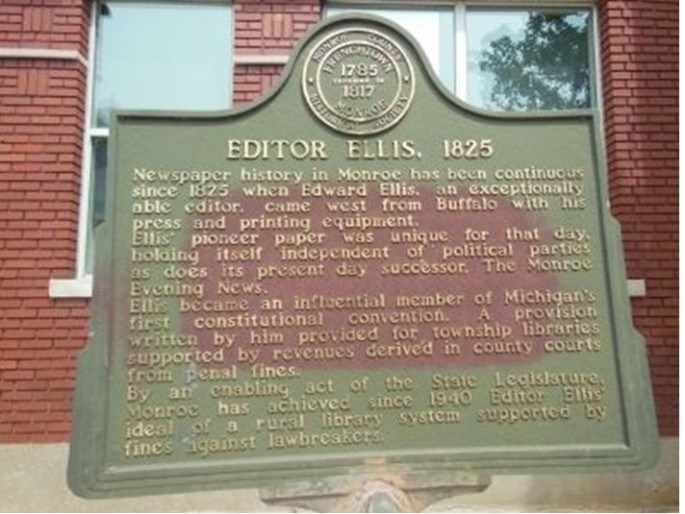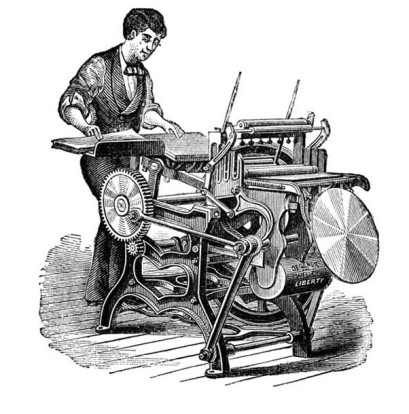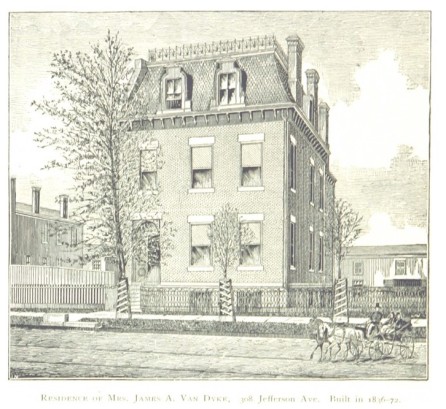 Edward Dimick Ellis settled in Monroe as a young man, established the Monroe Michigan Sentinel, and enhanced Monroe’s reputation as a thriving town welcoming ambitious newcomers. He and his career grew along with Monroe. While Edward served as a delegate to Michigan’s first Constitutional Convention in 1835, he persuaded the Michigan Legislature to establish common schools and township libraries. He served Monroe village and Monroe Township in various offices including clerk and director of the poor. He was a member of the Territorial Senate from 1935-1837 and he ran unsuccessfully for governor in 1837.
Edward Dimick Ellis settled in Monroe as a young man, established the Monroe Michigan Sentinel, and enhanced Monroe’s reputation as a thriving town welcoming ambitious newcomers. He and his career grew along with Monroe. While Edward served as a delegate to Michigan’s first Constitutional Convention in 1835, he persuaded the Michigan Legislature to establish common schools and township libraries. He served Monroe village and Monroe Township in various offices including clerk and director of the poor. He was a member of the Territorial Senate from 1935-1837 and he ran unsuccessfully for governor in 1837.
In 1836, Edward sold the Monroe Michigan Sentinel to Abner Morton and then he moved to Detroit and became associated with a paper called the American Vineyard.
Amanda Flower Ellis
The story of editor Edward Dimick Ellis begins in Massachusetts and New York with his father, Edward Ellis and mother Amanda Flower Ellis. During the winter of 1795, Edward and his brother John moved to Niles – now Sempronius, New York- from Ashfield, Massachusetts, to farm the 300 acres of land that Edward had purchased. Edward and Amanda were married in 1798, shortly after he moved to Sempronius and they appear in the 1799, 1800 and 1803 tax and census records. There were only six other families in town to share their taxes and their pioneer existence. In 1799, their son Cyrus was born and Edward Dimick appeared on October 7, 1801. Edward died, reportedly from overwork, two months before his son Edward was born and the family buried him behind the house that he had worked so hard to build.
A small and frail woman, Amanda Ellis made up for her lack of size in determination and durability. After her husband died, she took Cyrus and Edward and returned to Ashfield, Massachusetts, but after a few months she decided to move back to Sempronius. Leaving her son Cyrus with his Uncle Dimick Ellis, she and her baby son Edward began the journey back to Sempronius. During the over 200 mile trip, Amanda met Reverend Lyman Forbush, a young Presbyterian minister who was also bound for Sempronius. Eventually they were married and settled permanently in Sempronius for the rest of their lives, raising a large family of children-mostly daughters. Reverend Forbush died in Sempronius on August 7, 1826, leaving Amanda a widow for the second time. The 1830 census shows that Amanda stayed in Sempronius where she raised her large family of small children, the youngest two years old. She successfully meeting the challenges of both mother and fatherhood during her 41 years of widowhood.
Amanda retained her mental and physical powers until her death on November 14, 1867, when she was 88 years old, leaving over 200 children, grandchildren, and great grandchildren. She and Lyman are buried in West Niles Rural Cemetery in Cayuga County, New York, along with her son Cyrus and his family and other family members.
Edward Dimick Ellis Discovers His Career and Heads West
After Edward Ellis died and Amanda remarried, she and Reverend Forbush lived on the family homestead in Sempronius that she and Edward and John had created. Amanda and Reverend Forbush raised Edward on the farm and when he became a young man, they put him into service with a tanner to enable him to learn that trade. Edward hated the tannery, but had a passion for the printing trade. He took a position in a printing office in Auburn, New York and eventually became a proficient printer.

At age 20, Edward visited his grandparents and relatives in Ashfield, Massachusetts, and then went to Springfield and Boston, where he worked for some time as a journeyman printer. After his stint in Massachusetts, Edward made a roundabout trip through New York City, Poughkeepsie, and Cooperstown to his home in Sempromius. For several years before, during, and after his trip, Edward recorded his daily activities and his comments on the main events of his time in his journal. His daily writing sharpened his powers of observation and developed his writing skills.[1]
Early in 1825, Edward Dimick Ellis arrived in Monroe, Michigan with his printing equipment in tow. On May 17,1825 Edward announced in the Michigan Herald that he would soon be publishing a paper called the Michigan Sentinel in Monroe. He printed his first issue on June 3, 1825.( The Henry Clay Papers give June 24, 1825 as the date). Monroe’s businessmen quickly recognized the economic importance of the Monroe Sentinel and helped Edward locate an office for the newspaper and they and the townspeople bought advertising and subscriptions to the newspaper. The Michigan Sentinel was the first newspaper printed in Michigan Territory besides the Detroit Gazette.[2]
In his History of Monroe County Michigan, John McClelland Buckley observed that the Sentinel quickly gained supporters and subscribers and since “Ellis was and ardent Democrat, the dominant party of those days, he was soon brought into prominence.” Edward Ellis played in important part in the growth of Monroe and the southern part of Michigan.
Monroe and the Monroe Michigan Sentinel Grow
On November 22, 1825, Editor Ellis revealed his plans for the Monroe Michigan Sentinel to his readers. He wrote: “The Undersigned editor and proprietor of this paper respectfully suggest to merchants and others the propriety of extending to said establishment advertising and other patronage.”
He wrote that the Sentinel already had a large circulation in Monroe and Wayne Counties and he wanted to expand his circulation into Lenawee and Oakland Counties. He concluded his message by stressing that he had founded his newspaper on independent principles and he hoped that he could obtain a moderate share of their advertising business.
As well as the growth of his newspaper, Editor Ellis chronicled the events in Monroe as the village continued to grow in businesses and population. On January 26, 1926, he reported that a cold snap covered the River Raisin with thick ice, forcing most Monroe business men to close their establishments. In the printing office of Edward D. Ellis, boiling water applied to the type congealed immediately.
In June 1826, the Monroe County assessors reported that the total amount of property assessed amounted to $1,328.33, compared to $363.35 for 1825. The assessors reported that their census results for Monroe County provided the following figures:
Number of white males 1,436
Number of white females 1,182
Total inhabitants 2,618 as compared to the 1820 census population figure of 1,851,
Lenawee County (attached to Monroe).
Number of white males 144
Number of white females 123
Total inhabitants 267[3]
Editor Ellis made political connections during his early years in Monroe. An important endorsement in his business life suggests that Edward met Governor Lewis Cass when the Governor passed through Monroe on June 1, 1825, on his return trip from an Indian Council in Wapakoneta, Ohio. Just a week later on June 9, 1825, after he returned to Detroit, Governor Cass recommended that printing of territorial laws, including Michigan Territory, take place in the Monroe Michigan Sentinel. On July 5, 1825, in the absence of the Secretary of State, Daniel Brent replied to Governor Cass, announcing a decision to appoint Edward Ellis as publisher of laws and requesting that he be given this information. [4]
On May 2, 1827, Monroe Township held its first election and Edward Ellis was chosen township clerk and on May 12, 1827, Monroe Village held its first election, choosing Edward Ellis as one of the village trustees. The La Plaisance Bay Harbor Company chose Edward Ellis as its secretary on May 30, 1827. In the Monroe Township election of April 14, 1832 , Edward Ellis was chosen as Director of the Poor and in 1834, he was elected Township Supervisor. [5]
Edward Ellis Marries Leonora Mary Chapman
On February 2, 1830, Edward Dimick Ellis married Leonora Mary Chapman in Monroe. She was born in Buffalo, New York on March 25, 1805, the daughter of Asa Chapman a pioneer resident of Buffalo, and a millwright and builder of grist and saw mills in New York and Ohio. Before her marriage, Leonora and a younger sister Permelia, went to Kentucky to teach in families, since public schools didn’t exist in that section and nearly every family hired teachers. Miss Leonora Chapman taught in the family of General Gaines, a prominent Kentucky citizens, for several years.
After Edward and Leonora were married, one building served as a printing office and a home for the couple and their young family. They eventually had six children: Mary Minerva Ellis, Amelia Ellis, Edward Charles Ellis, John C.C. Ellis, Elizabeth T. Ellis, and Benjamin F. Ellis. All their children were born in Monroe, but Benjamin who was born in Detroit.
Mrs. Leonora M. Ellis was a woman of superior education and culture. After the death of her husband in 1848, she resided with her children in Chicago and Detroit, the last few years with her eldest daughter, Minerva, in Detroit, where she died August 26, 1870.
Shaping the First Michigan Constitution
The year 1835 shaped up to be an especially political one for Editor Ellis. In a letter dated April 1, 1835 he and other Monroe residents petitioned Michigan Governor Stevens Mason to appoint Joseph Loranger Jr. as an additional land auctioneer for the upper part of Monroe County.”[6]
In a more politically significant development, Editor Ellis helped create Michigan Territory’s first constitution. The Northwest Ordinance of 1787 governing Michigan Territory and the Act of January 26, 1805, provided for electing delegates to establish a convention to form a constitution and state government once the population of the territory had reached 60,000 free inhabitants. By September 1834, Michigan Territory’s population had reached 87,273. Delegates were elected in April 1835, and Michigan Territory’s constitutional convention convene in Detroit, the territory’s capital on May 11, 1835. Edward Ellis served as one of the convention delegates from Monroe. He played an important part in shaping the convention, introducing the concept of common schools and a bill providing that penal fines should be used to support libraries in every township in the state, an essential provision that would provide funds for existing and yet to be created libraries. Michigan voters approved the constitution on October 5 and 6, 1835. [7]
As a Whig, Edward Ellis served as a member of the Territorial Senate in 1835, and in 1837 he ran an unsuccessful race for governor as a Democrat. In keeping with his Whig politics, in August 1847, Edward Ellis along with his friend Isaac S. Smith, wrote General Zachary Taylor, a prominent Whig more interested in war than politics, a letter. Dated August 18, 1847, the letter urged General Taylor to be the People’s Candidate for president the next year and informing him that the citizens of the Northwest would prefer the selection of William Woodbridge, second governor and senator from Michigan, as the vice-president.
Editor Ellis expressed his disdain for a new movement of Anti-Slavery Whigs that would ultimately help create the Republican Party in 1854.
“We are seeing among the number by no means few, of the of the citizens of the North-West, who condemn the useless and mischievous agitation of the questions calculated to disturb the peace and tranquility of other portions of the Union; and in view of the probable attempted formation of a political party in these Northern states, having for its motto and objects, a warfare, as we conceive in derogation of the principals of the Constitution and the laws of the National Compact, upon the peculiar institutions of our sister states -we are disposed to cooperate with our fellow citizens elsewhere in supporting, as the People’s candidate for the Presidency, General Zachary Taylor of Louisiana.”
General Taylor replied to the letter and although the impact of the letter’s persuasive powers can’t be fully measured, General Taylor did run for and win the presidency in 1848.[8]
Editor Ellis and the American Vineyard

In 1836 Ellis sold the Monroe Michigan Sentinel to fellow Monroe citizens Abner Morton & Sons. Monroe County historians Talcott Wing and John Buckley present contrasting versions of what happened to the Sentinel after that. One version says that Abner Morton and his sons moved the Monroe Michigan Sentinel to Detroit and operated it in connection with the American Vineyard which they published. The other version of the story says that Edward Ellis moved to Detroit and became founding editor of the American Vineyard which Silas Farmer lists as a Temperance, Anti-Catholic newspaper, with its last issue being published in Detroit on May 14, 1848. [9]
Abner Morton sold the Monroe Sentinel to E.J. Van Buren who moved it to Pontiac. Abner Morton moved back to Monroe and founded the Monroe Advocate.
Edward Dimick Ellis died in Detroit on May 15, 1848, one of the best known and influential journalists in Michigan.[10]
Notes
[1] Biographical Sketches of Richard Ellis: The First Settler of Ashfield, Mass. and His Descendants. Edward Robb Ellis. Higginson Book Company 1989, p.23
[2] Pioneer Society of Michigan, Pioneer Collections Report of the Pioneer Society of the State of Michigan, Volume I,N.S. George Printers and Binders, 1877, p. 395
[3] History of Monroe County, Michigan: a narrative account of its historical progress, its people, and its principal interests. John McClellan Buckley. Chicago: Lewis Publishing Company, 1913, p. 67.
[4] The Papers of Henry Clay, Secretary of State, 1825, Volume 4. The University Press of Kentucky, 2015, p.428.
[5] History of Monroe County, Michigan, Talcott E. Wing, Editor. New York: Munsell & Company, Publishers, 1890, p.76.
[6] A. L. S. Approved Mar. 30, 1835. Terr. Laws, ‘Vol. ill, p. 1421.
[7] Michigan Pioneer and Historical Society. VOL. XXXVII Lansing: Wynkoop, Hallenbeck, Crawford Co., 1909-1910. P. 330.
[8] The papers of John C. Calhoun, Volume XXIV, 1846-1847. Alexander Moore, Associate Editor. Columbia, South Carolina: University of South Carolina Press, 1998. pp 486&497.
[9] A history of Detroit and Michigan or the Metropolis Illustrated, Silas Farmer. Detroit: Silas Farmer & Company, 1889., p. 31.
[10] Edward and Leonora Ellis’s daughter Mary Minerva and her cousin and husband Dr. Erastus Ranney Ellis are buried in Elmwood Cemetery in Detroit.
